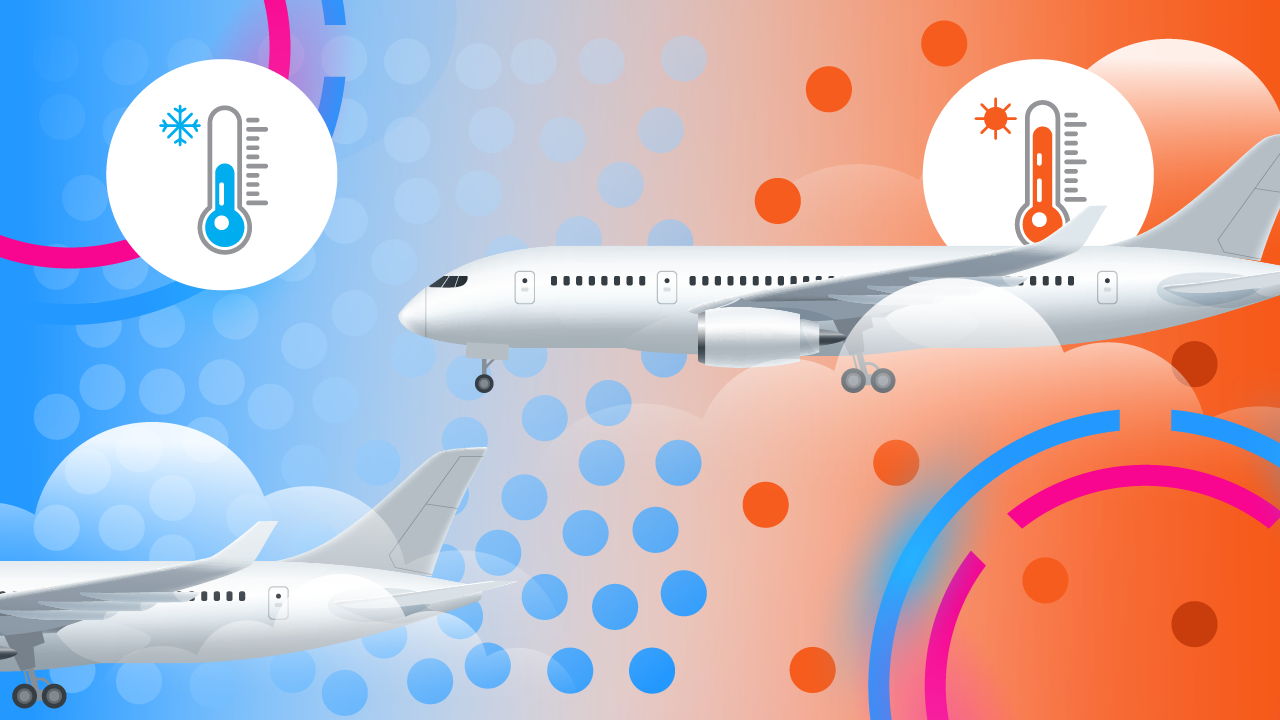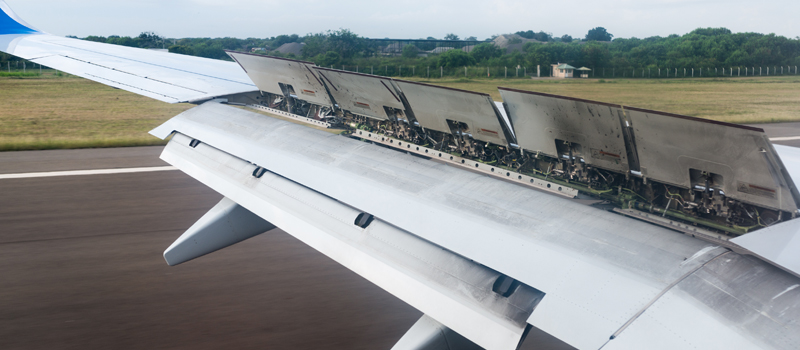-
Key Takeaways
-
Introduction
-
What Is Pressure Altitude?
-
What Is Density Altitude?
-
Why Does Density Altitude Affect Aircraft Performance?
- Wings
- Propellers
- Engines
-
How to Convert Pressure Altitude Into Density Altitude
- How to Find Pressure Altitude
- How to Find ISA Temperature
- How to Find Actual Temperature
- How to Calculate Density Altitude
- Alternate Methods for Finding Density Altitude
-
What Happens to Aircraft in High Density Altitudes?
- Takeoff
- Climb
- Landing
-
How to Use the Koch Chart
- Steps
- Examples
-
Safety Tips
-
Conclusion
You may have read about density altitude mentioned as a factor in an air crash.
Perhaps you heard about it during training or were warned by a veteran pilot.
But what makes density altitude different from pressure altitude, and why should pilots be cautious about it?
Even experienced pilots often underestimate how drastically density altitude can affect aircraft performance.
In this article, we’ll clear up your concepts about density altitude, show you how to calculate it, and explain exactly why it’s so dangerous.
Key Takeaways
- Discover how the atmosphere’s structure affects air density and its relationship to pressure altitude.
- Understand how density altitude impacts aircraft performance by altering lift, engine power, and propeller efficiency.
- Learn how to convert pressure altitude into density altitude using calculations and how to verify your results.
- Explore how to determine changes in takeoff distances and climb rates without calculating density altitude.
Introduction
Air may be light, but it does have mass. Gravity acts on this mass, giving air its weight. Heavier air molecules accumulate near the ground, with lighter components stacking above them. This forms the basic structure of the atmosphere, which is thick near the surface and generally thins out as you go up.
Air density measures how ‘thick’ the air is. Dense air has more air particles exerting forces on each other. These forces act in all directions since air is a fluid. The combined effect of these forces creates atmospheric pressure.
What Is Pressure Altitude?
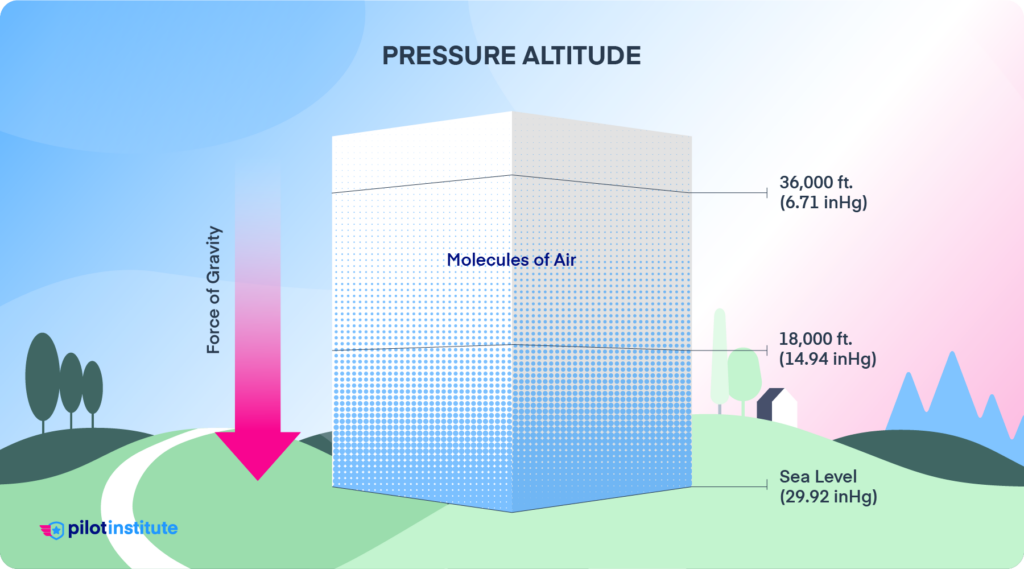
Standard aircraft altimeters don’t directly measure altitude – they measure atmospheric pressure. Atmospheric pressure decreases as altitude increases. So, if you want to know your altitude, just find out the decrease in atmospheric pressure from sea level.
The relationship between atmospheric pressure and altitude is nearly linear near the ground. But it gets progressively non-linear with increasing altitude. Variations in temperature and humidity complicate the relationship.
To make matters easier, aviation uses a standard called ISA (International Standard Atmosphere). This simplifies the temperature change rate (called a lapse rate). It also sets standard pressure values at different altitudes.
In ISA:
- Atmospheric pressure at sea level is 29.92 inHg (1013.25 hPa).
- At 18,000 feet, the pressure is 14.96 inHg (506.63 hPa), down to roughly half the original value.
- At 36,000 feet, the pressure drops to 6.68 inHg (226 hPa), one-fourth of the pressure at sea level.
The altimeter is calibrated to display altitude based on this standard model. It makes calculations simpler and maintains uniformity for every aircraft.
Whenever the altimeter is set to standard pressure, 29.92 inHg, the reading shows the Pressure Altitude.
What Is Density Altitude?
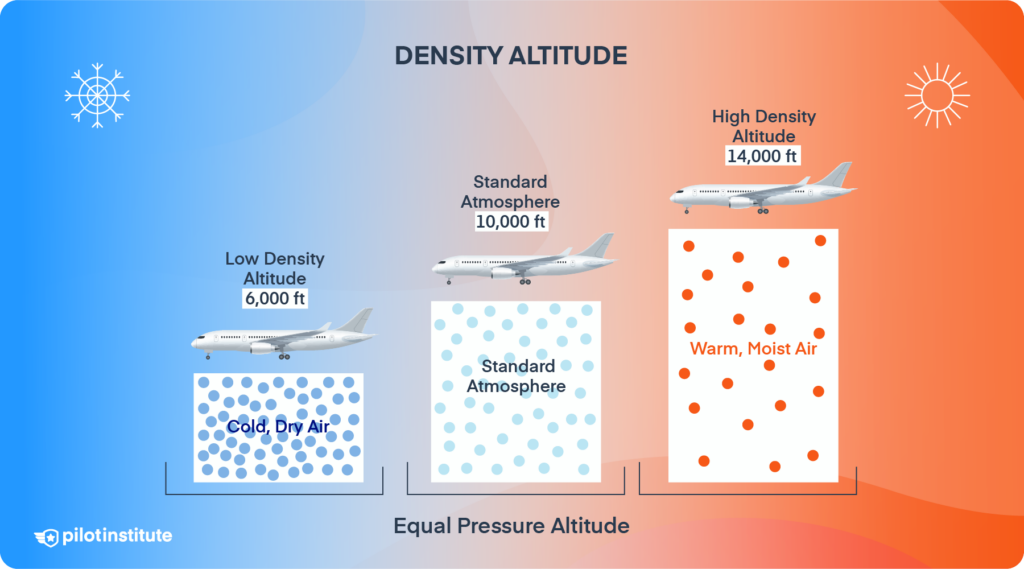
Density altitude is the pressure altitude adjusted to account for temperature and humidity. Both these factors affect air density. Low air density makes the aircraft perform as if it were flying at a higher pressure altitude. Increased air density has the opposite effect.
We can usually ignore temperature and humidity when measuring altitude. Generally, pressure altitude and density altitude don’t differ greatly close to the ground. Temperature and humidity at many locations are close to the conditions set by the ISA model. The issue arises with excessively high temperature, humidity, or both.
So, what are the effects of temperature and humidity on air density?
If other conditions are constant,
- An increase in temperature decreases air density.
- An increase in humidity decreases air density.
Temperature decreases air density as the air particles spread apart due to increased kinetic energy.
Humidity decreases air density because water vapor is less dense than the dry air components it displaces. Higher humidity means more water vapor in the air, leading to lower air density.
Why Does Density Altitude Affect Aircraft Performance?
Wings
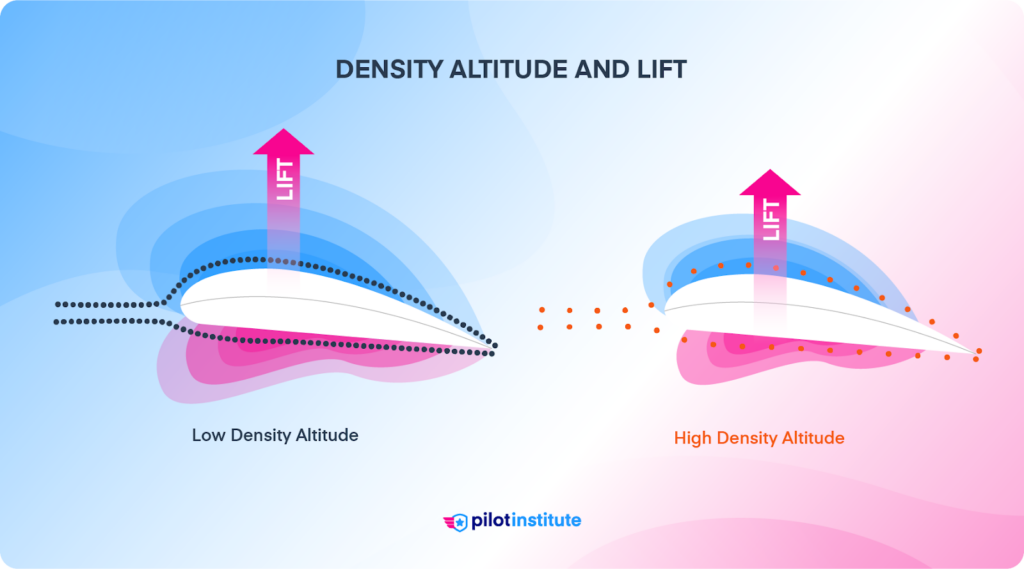
Wings generate lift due to their curved shape, known as an airfoil. The difference between the high pressure on the underside of the airfoil and the relatively low pressure above it creates lift.
Lower air density means fewer air particles are available to create the pressure differential. This reduces the wing’s effectiveness and limits the lift it can generate.
Propellers
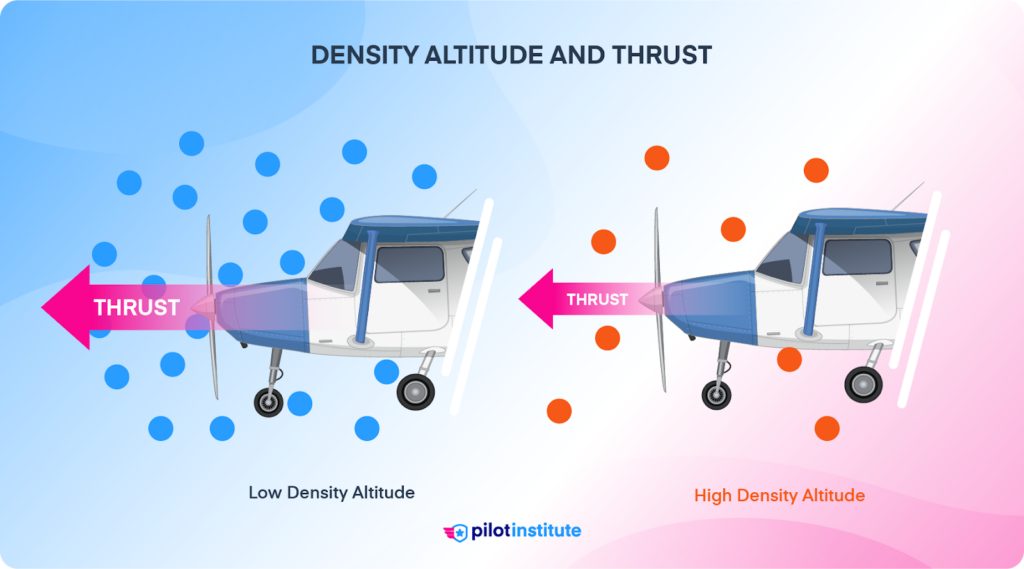
Propeller blades are airfoils, too! They create a similar pressure differential between the forward and aft sides of the blade. The lower air density reduces the amount of air the blade scoops backward.
Aircraft equipped with variable-pitch propellers can increase the blade pitch. This lets them catch more air particles in each rotation.
If your aircraft has fixed-pitch propellers, you’ll be stuck with low thrust when flying at high density altitudes.
Engines
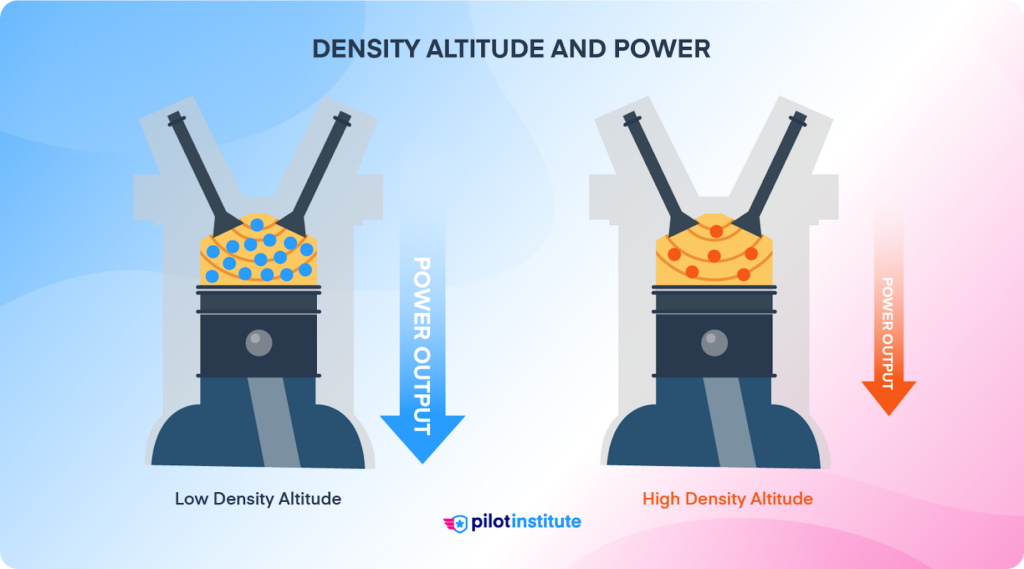
Aircraft engines rely on the intake of air mixed with fuel to create combustion. Low air density means insufficient oxygen is available for the fuel to burn cleanly.
Turbine engines compress air before mixing it with fuel. This helps counter some of the effects of low air density.
Naturally-aspirated piston engines depend directly on the intake air density. A lack of oxygen drastically reduces their power. They’re also sensitive to humidity since they operate at lower temperatures and pressures.
How to Convert Pressure Altitude Into Density Altitude
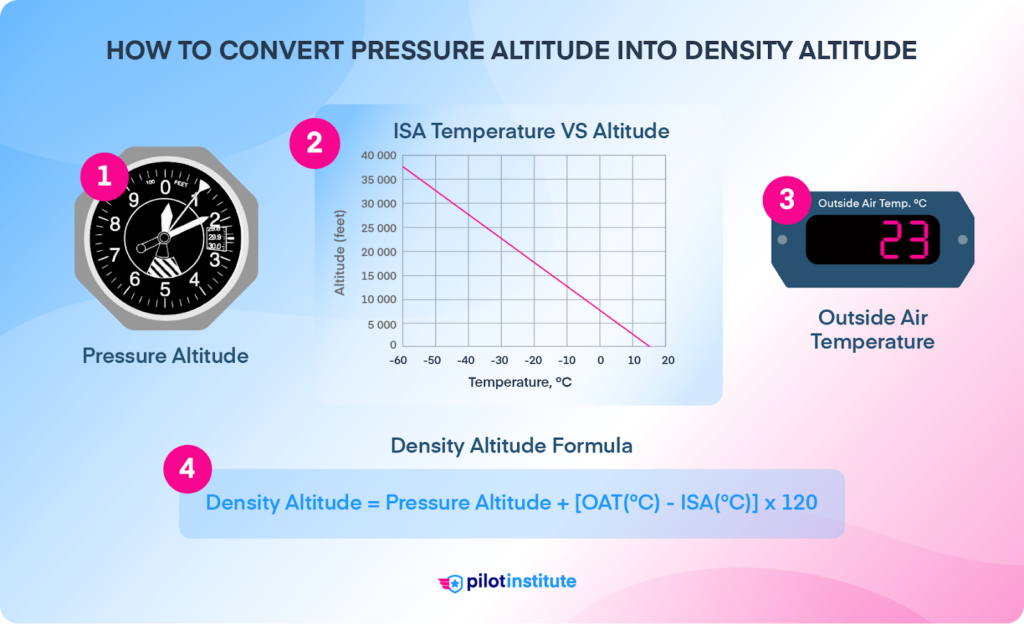
Here’s an overview of the process:
- Find the pressure altitude.
- Find the ISA temperature for your pressure altitude.
- Determine the actual temperature at the pressure altitude.
- Use the rule of thumb to find the density altitude.
How to Find Pressure Altitude
This is the aircraft’s altitude compared to the ISA atmosphere. You can read the pressure altitude directly if you set your altimeter to the standard pressure setting of 29.92 inHg (1013.25 hPa).
If you want to calculate the pressure altitude at an airport without using the altimeter, you can use a simple equation. All you need to know is the local altimeter setting and the airport field elevation.
Pressure Altitude = (29.92 − Altimeter Setting) x 1,000 + Elevation (ft)
For example, let’s say you want to calculate the pressure altitude at your destination airport. The airport is at 1,500 ft. MSL and has a local altimeter setting of 29.85.
Pressure Altitude = (29.92 − 29.85) x 1,000 + 1,500
Pressure Altitude = 70 + 1,500
Pressure Altitude = 1,570 ft. MSL
In U.S. airspace, all aircraft flying above the transition altitude of 18,000 feet MSL have their altimeters set to standard pressure.
If flying below the transition altitude of 18,000 feet MSL, use the local altimeter setting called the QNH. Pilots get updated QNH settings from the ATIS or as advised by air traffic control. Altimeters have an adjustment knob to set the reference pressure setting. Rotate the knob until the dial in the Kollsman window shows 29.92 to set it to standard pressure.
How to Find ISA Temperature
In ISA, the temperature at sea level is +15° Celsius (+59° Fahrenheit).
The standard temperature lapse rate is approximately 2°C per 1,000 feet up to 36,000 feet.
In other words, temperature decreases by 2°C for every 1,000 feet of altitude. You may manually calculate the temperature for your pressure altitude or use a handy formula.
ISA temperature = 15 – (2 x (Pressure Altitude / 1000))
So, for example, at a pressure altitude of 6,000 feet:
ISA temperature = 15 – (2 x (6,000 / 1000)
= 15 – (2 x 6)
= 15 – 12
= 3°C
How to Find Actual Temperature
Most aircraft have an outside air temperature (OAT) gauge. Glass cockpit aircraft may have an electronic OAT sensor, but both types are equally accurate.
Simply read the temperature off the gauge.
The NWS’s Aviation Weather Center offers forecasts for temperatures aloft here. They’re only available for a limited number of altitudes and don’t include current observations. Use them only as a reference for flight planning.
How to Calculate Density Altitude
Now that you’ve gathered all the required data, you can plug it into a formula to find the density altitude.
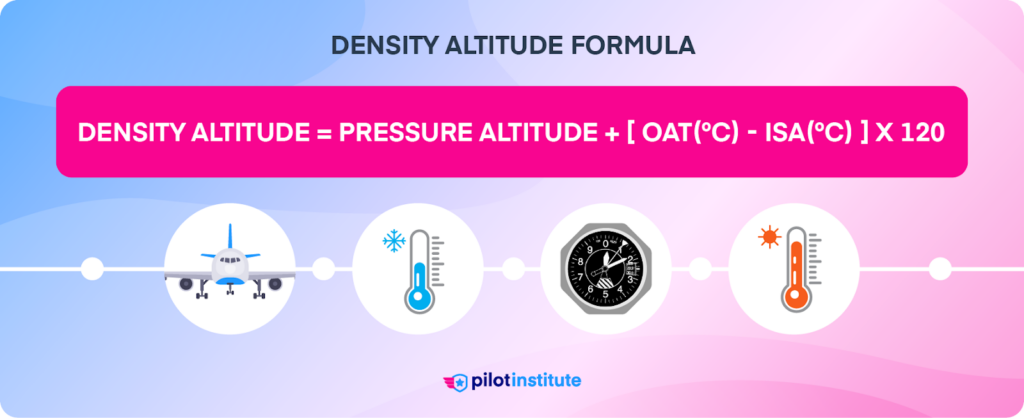
The rule of thumb is that density altitude changes by about 120 feet for every 1°C temperature deviation.
- Determine the temperature deviation by subtracting the ISA temperature from the actual temperature.
- Multiply your answer by 120 to get the altitude deviation.
So, for an OAT of 10°C and the ISA temperature calculated earlier at 3°C, the altitude deviation is:
(10 – 3) x 120
= 7 x 120
= 840 feet.
Add the altitude deviation to the pressure altitude to get the density altitude. In our example, we add 840 to 6,000 to get 6,840 feet as our density altitude.
Let’s take the OAT as -2°C instead. The calculation changes to:
(-2 – 3) x 120
= -5 x 120
= -600 feet
Adding the altitude deviation to the pressure altitude gives us:
6,000 + (-600) = 5,400 feet.
You may wonder why we did not explicitly calculate humidity and its effect.
For one, most aircraft aren’t even equipped with instruments capable of measuring relative humidity. Secondly, humidity primarily depends on temperature. The ISA temperature lapse rate of 2°C represents an average of the dry and moist lapse rates. In other words, the lapse rate includes the estimated effect of humidity.
Alternate Methods for Finding Density Altitude
A more direct method would be to use a density altitude chart. The FAA’s Pilot Handbook offers the chart below. You may use it to check your calculated answers.
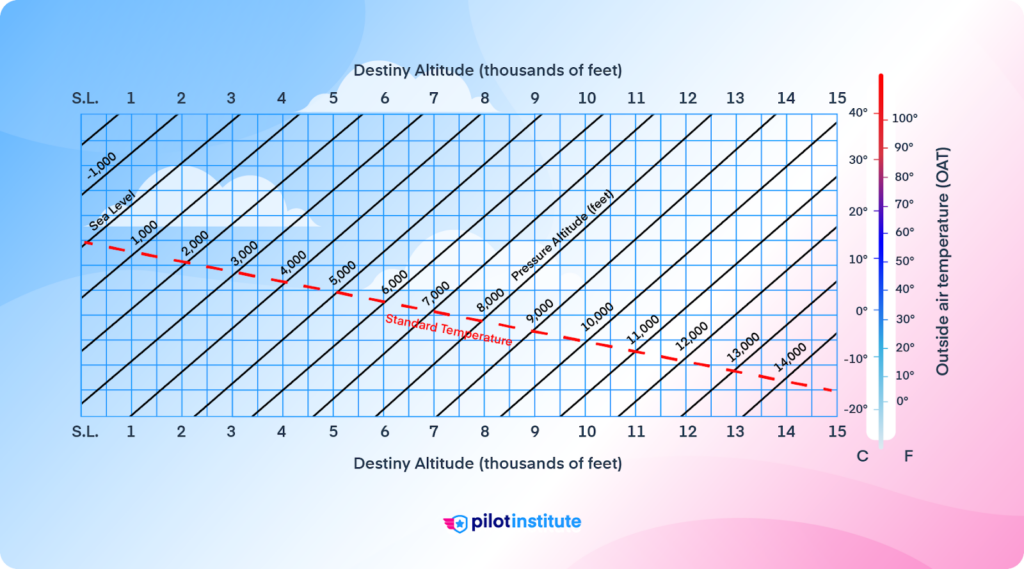
If you’re good with a flight computer, you can use one to find the density altitude. Read our guide here for more information on calculating density altitudes using the flight computer and the chart.
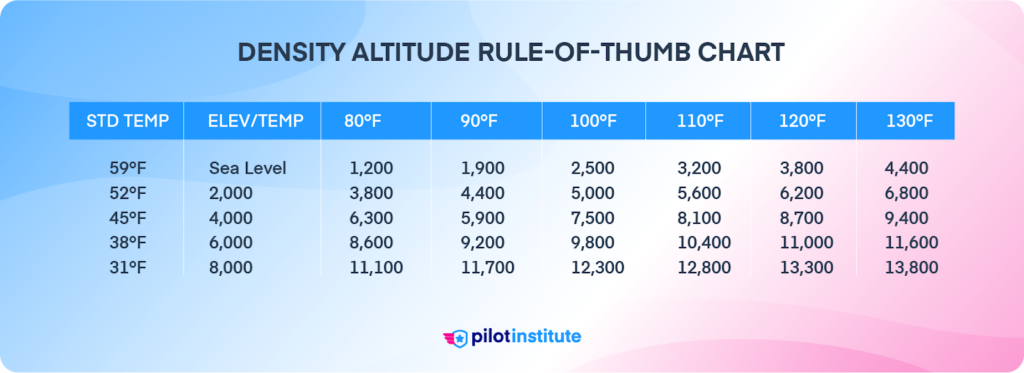
For a quick and rough density altitude calculation, you can reference this rule-of-thumb chart. For example, if your airport sits at a pressure altitude of 2,000 ft. and the temperature is 100°F, expect the density altitude to be around 5,000 ft. If we crosscheck with the density altitude formula, we get a density altitude of 5,192 ft.
What Happens to Aircraft in High Density Altitudes?
Density altitude will affect the aircraft throughout the flight. Let’s examine the impact at each stage.
Takeoff
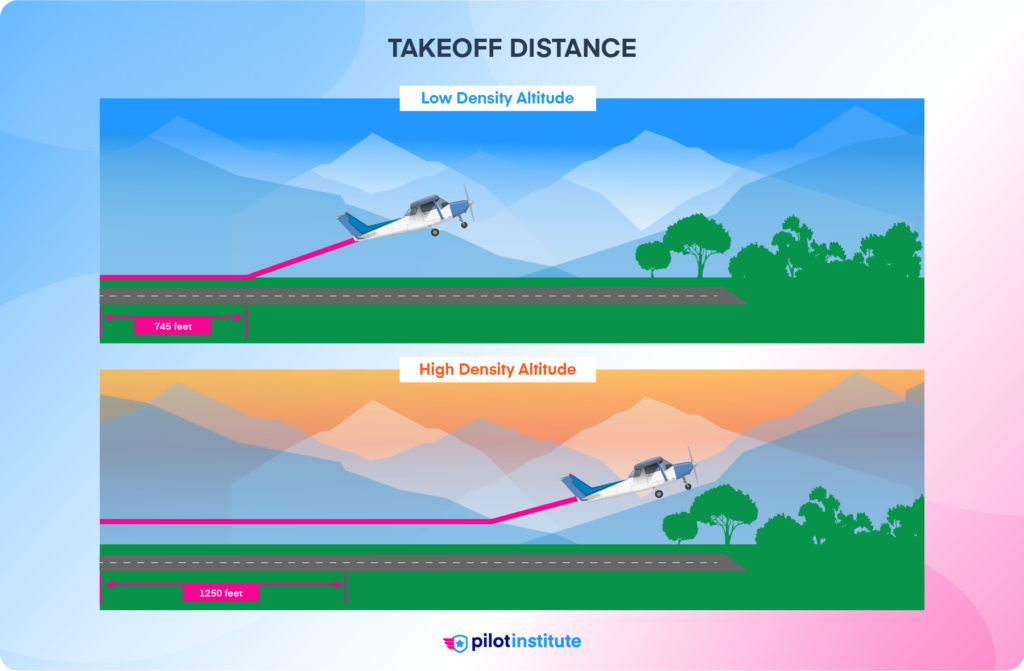
The reduced ability of the wing to generate lift means the aircraft will have to accelerate to a higher speed to take off. This increases the takeoff distance required.
But that’s not all! Remember, the aircraft also suffers from reduced thrust from the engines. The propeller is less efficient, too. This reduces the aircraft’s rate of acceleration. The aircraft requires even more runway to achieve a higher takeoff speed.
The FAA’s density altitude pamphlet suggests adding 10 percent to your takeoff distance when departing in high humidity.
Climb
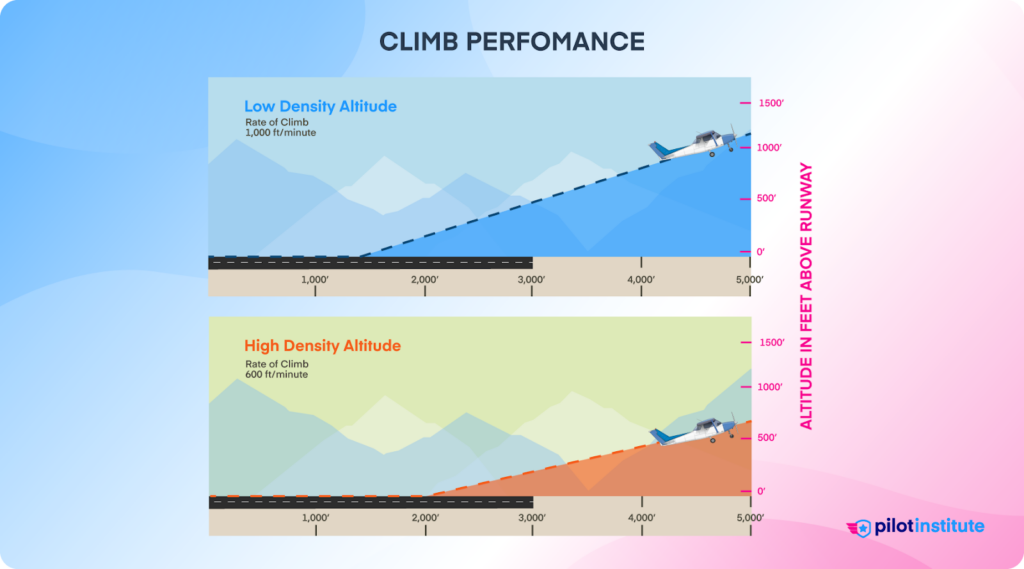
With all three factors continuing to degrade its performance, the aircraft may only manage a sluggish climb. The effects only worsen as the aircraft climbs higher.
High density altitude is an inherent danger at high-elevation airports. The aircraft’s degraded performance can prove deadly when surrounded by high terrain. Keep your aircraft’s capabilities in mind when you plan your route.
Landing
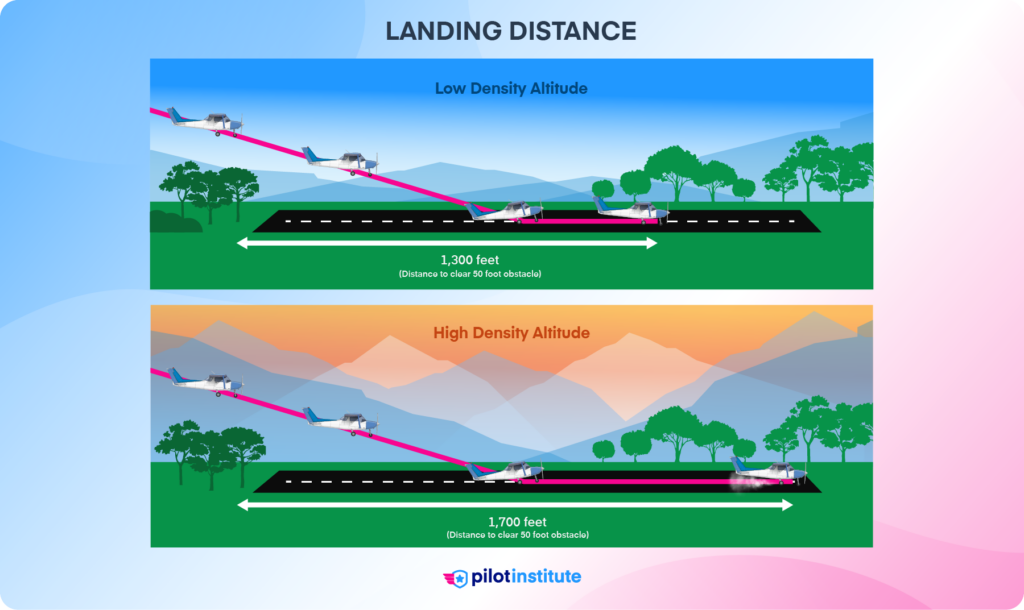
The reduction in lift means the aircraft has to land at a higher groundspeed.
Although you’ll be at your usual Indicated Airspeed (IAS) during the approach and landing, your True Airspeed (TAS) will be higher. The higher TAS leads to a higher groundspeed. That’s why your landing roll will be longer and you’ll need more runway to come to a stop.
How to Use the Koch Chart
You can estimate performance degradation without computing density altitude. Your POH/AFM remains the primary source.
The Koch chart gives an approximate percentage change in performance from standard conditions.
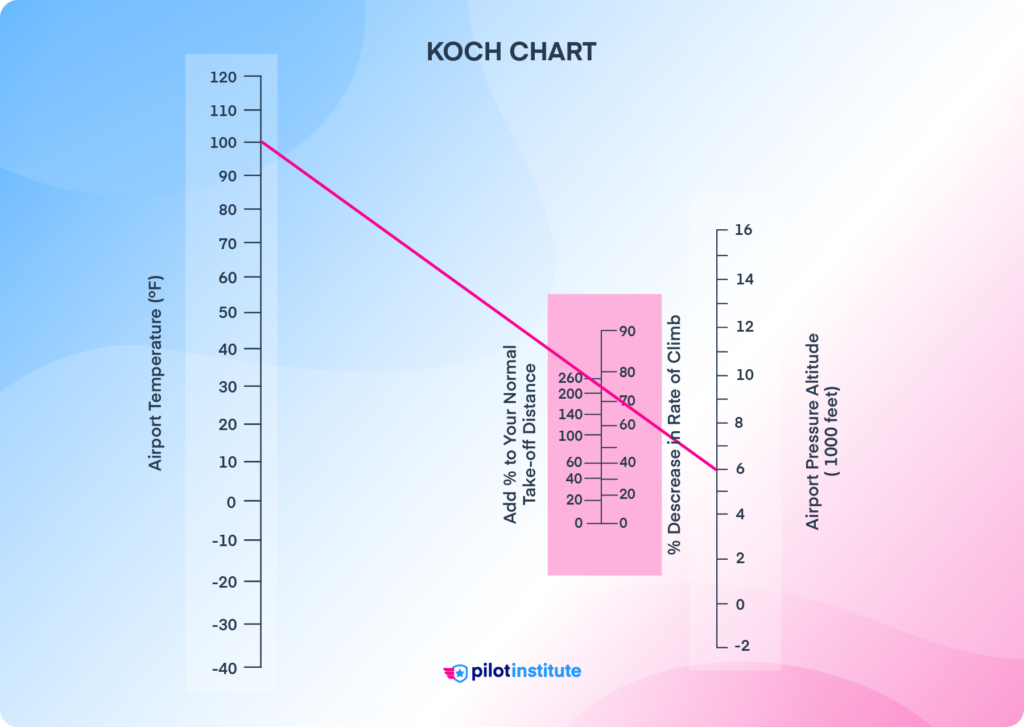
Steps
- Start by setting your altimeter to 29.92 inches. The reading shows the pressure altitude. Mark it on the right scale on the chart.
- Set the altimeter to 29.92 inHg to read pressure altitude and mark it on the right scale.
- Mark the outside air temperature on the left scale.
- Draw a straight line between those marks. Where it crosses the middle scales you’ll read:
- “Add % to your normal takeoff distance.”
- “% decrease in rate of climb.”
Important: The chart shows percent changes, not final values.
- For takeoff distance, the number is the percent to add to your normal (baseline) distance.
- Final takeoff distance = Baseline × (1 + %increase/100).
- For rate of climb, the number is the percent to subtract from your normal ROC.
- Final ROC = Baseline × (1 − %decrease/100).
If the chart shows 0%, your performance stays at the baseline (it doesn’t become zero).
Examples
Rate of climb: Normal ROC 500 fpm, chart shows 76% decrease →
500 × (1−0.76) = 500 × 0.24 = 120 fpm.
- Takeoff distance: Normal takeoff roll 1,000 ft, chart shows +230% →
- Added distance = 1,000 × 2.30 = 2,300 ft
- Final distance = 1,000 + 2,300 = 3,300 ft.
You can read more about the Koch Chart through the FAA’s Density Altitude documentation.
Safety Tips
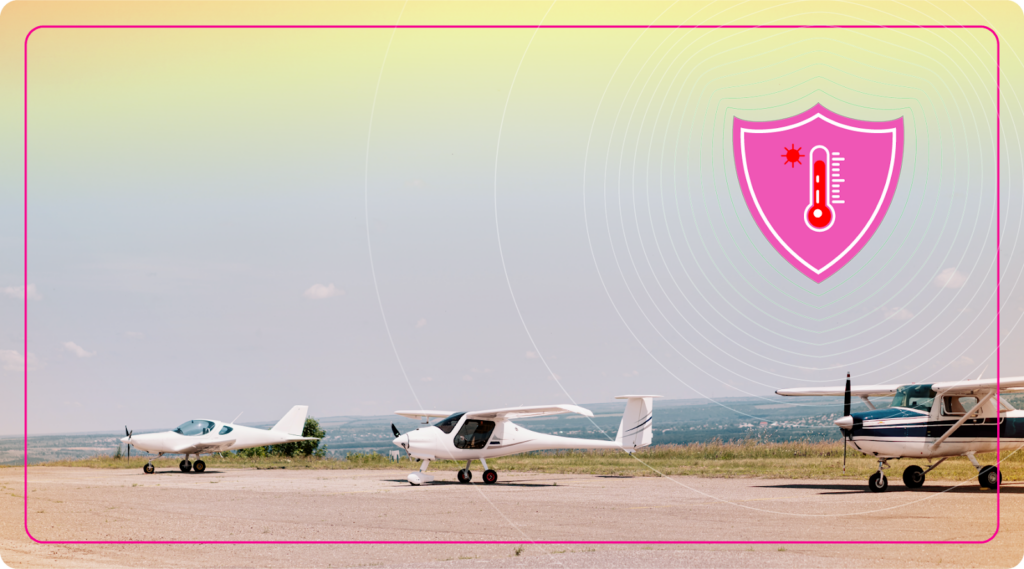
- Reschedule your flight to the cooler hours of the day. Early morning and late evening operations will help you avoid high temperatures.
- Be conservative about your aircraft’s weight. Consider not topping off the fuel and offloading some payload. Every pound helps when you’re struggling to get airborne.
- Divide your route into short legs. Your aircraft will be lighter, and it’ll be easier to manage the performance loss. As a bonus, you get lots of practice in low air density operations!
- If you rarely encounter high density altitudes at your local airport, consider practicing in a hot and humid location. Many pilots are surprised by how severe the performance degradation can be. If you’re prepared for the conditions, you’ll avoid nasty shocks at critical moments.
- Decide ahead of time when to abort the takeoff or landing. For example, abort the takeoff if the aircraft hasn’t accelerated to 80% of the takeoff speed halfway along the runway.
- If your aircraft has a naturally aspirated engine, lean the mixture in high density altitude conditions. An excessively rich mixture reduces performance and risks spark plug fouling. Lean the mixture at power settings lower than 75 percent and at density altitudes greater than 5,000 feet.
- Routinely encounter high density altitudes? A turbocharged or supercharged aircraft may be a worthy investment. Forced induction engines handle these conditions better but won’t entirely eliminate performance loss.
Conclusion
Now that you understand density altitude and its consequences see how weather phenomena complicate atmospheric pressure on a massive scale.
Learn more about high and low pressure systems here.
